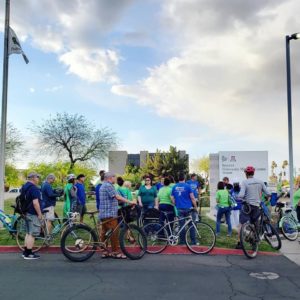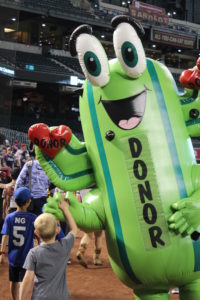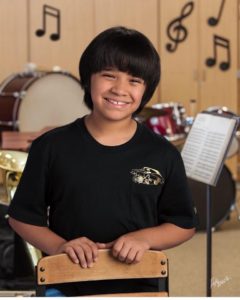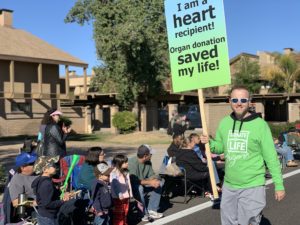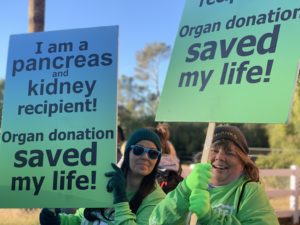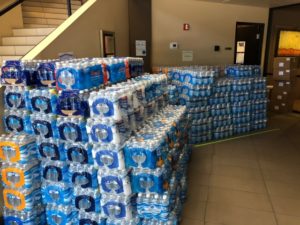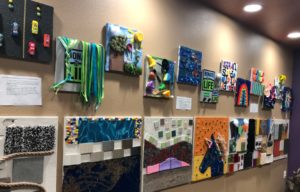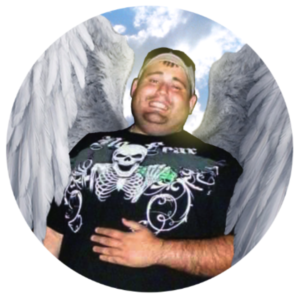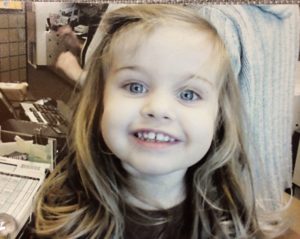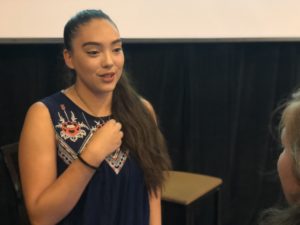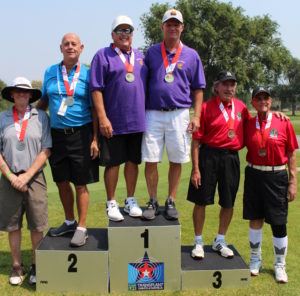Changed for Good | Saving Lives in National Donate Life Month
Zoe Mar was a bright and bubbly teenager who loved singing, acting, socializing and the color pink. In 2017, the Ahwatukee girl suffered a brain aneurysm that caused irreversible damage. The loss was sudden, unexpected and devastating.
In the midst of overwhelming grief, Zoe’s parents, Bob and Trena Mar, made the selfless decision to donate Zoe’s organs, because it was “the right thing to do.”
Jovani Perez, 7, was one of four people who benefited from Zoe’s organs.
Jovani had been born with two small, low-functioning and underdeveloped kidneys. He was placed on the wait list just two weeks before his family got the call that there was a kidney available for him.
The Perez family knew nothing about the donor, but they wanted to say thank you.
“During the hardest time, they chose to give life,” says Amber Perez, Jovani’s mom.
The opportunity to give that thanks arose this April. The Mar family finally met Jovani, who wore a pink bow tie for the occasion. At Phoenix Children’s Hospital on April 9, Bob and Trena held a poster full of photographs of Zoe and shared stories about the bright, energetic teen with the Perez family.
“I guess parents are supposed to be the ones to give the joy and the love and all that, and you just don’t think it’s the child that’s giving it to us, but she just, she was our life,” says Trena. “Seeing [Jovani] run around and be the same bolt of energy Zoe was, it just fills a part of me that has been empty for a long time.”
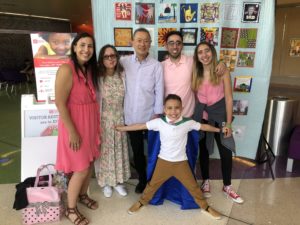
The Perez family meets the Mar family. (l to r: Amber Perez, Trena Mar, Bob Mar, Jovani (front), Ben Perez, Jari Perez)
Heroes for Hope
April is National Donate Life Month, and hospitals, health care organizations and donation supporters all over Arizona advocated for donation in collaboration with Heroes for Hope. Heroes for Hope is Donor Network of Arizona’s outreach campaign that joins together hospital, health care and emergency response organizations with the common goal to save and heal lives through organ, eye and tissue donor registration.
There are more than 2,100 people in Arizona waiting to receive a lifesaving transplant.
Collaboration among Arizona’s health care professionals to increase the number of registered donors on the DonateLifeAZ Registry can mean fewer deaths on the organ transplant waiting list and improved quality of life for those waiting to receive a tissue or cornea transplant. In total, Arizona health care partners helped more than 840 new individuals join the more than 3.6 million on the DonateLifeAZ Registry in April.
As part of Heroes for Hope, Phoenix Children’s Hospital hosted these two special families to help them tell their story of hope and healing through donation.
Flying Basset Brewing, a local brewery in Gilbert, thought outside the box, and offered a discount to customers who registered or showed the DONOR 
Banner – University Medical Center Phoenix also participated in the Heroes for Hope, bringing in more than 120 new registrations, and hosting tabling events, a flag-raising ceremony and a bike ride for National Blue and Green Day. Always eager to go above and beyond, they also shared countless stories of donation on their BUMCP4Hope Facebook page.
Krystal McCluney, a registered nurse at Banner – University Medical Center Phoenix, spoke to fellow health care professionals at the Heroes for Hope kickoff breakfast in March.
“We all possess an incredible super power within ourselves to help others,” says Krystal. “We can all make the choice to sign up and be a hero. It’s even more heroic to dedicate an entire month of your time to educating others and asking them to register as organ donors.
Donation has this incredible ripple effect: it does not just affect the recipient. It also affects their families, and generations afterwards. The stories influence complete strangers. And we cannot forget how it touches the families involved with such a heroic sacrifice.
I have seen donation first hand, many times. And every time it is raw and emotional, it is tragic and it is beautiful. Families are going through some of their darkest times, and donation brings a small glimmering light: that is the true super power of donation. It creates the promise of hope during a time of uncertainty and heartache. Remember that this April is about having fun, being creative, and changing lives. By being here today, you are dedicating yourself to educating our public and helping them to get excited about donation! You are true Heroes for Hope!”
Home Run for Donation!
“My heart was racing!” Heather Jauregui said shortly after throwing the first pitch at a Diamondbacks game April 14, 2019. But she’s grateful her heart can beat properly.
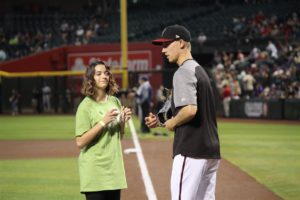
Heart valve recipient Heather Juaregui gets ready to throw the first pitch at the 13th annual Donate Life Day at the D-backs.
Heather was born with a congenital heart defect, known as absent pulmonary valve syndrome (APVS). Someone with APVS has an underdeveloped or missing pulmonary valve, which is supposed to supply blood to the lungs for oxygen.
Because Heather’s heart had to work much harder than a healthy heart, doctors at Phoenix Children’s Hospital performed open heart surgery on her to replace the valve when she as only four months old. She underwent another surgery nine years later to receive a new heart valve when the initial replacement started to leak.
Today, Heather is a healthy 12-year-old girl with a renewed zest for life and a continual sense of gratitude for the gift of donated tissue that saved her life.
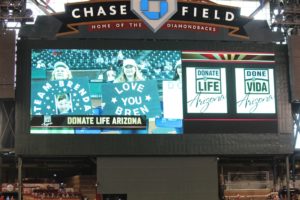
Family and friends of donor Brenda Alvarez are recognized on the D-backs field on behalf of Brenda’s generous gift of life.
“I know I am very lucky because sometimes babies with heart defects do not survive other complications,” she says. “I’m very thankful to the organ donor who gave me my heart valve and to their family who must have been so sad but still so giving.”
Hitting it Out of the Park
The Arizona Diamondbacks honored Heather’s donation journey by inviting her to throw the first pitch at the 13th annual Donate Life Day at the D-backs event. It’s safe to say that this event is always a big hit!
Over 1,300 fans of donation attended a D-backs game against the San Diego Padres to show their support for organ, tissue and cornea donation. The D-backs invited families touched by donation onto the field to recognize their loved ones’ gift of life and their own journeys with transplantation.
Donate Life Arizona holds this event every year to both honor those who have given and receive life through donation, and also to encourage the numerous Arizona sports fans to say “yes” to donation. Fans stopped by the registration table at the ballpark to learn more about the lifesaving and healing benefits of donation and registered to be a hero.
Reggie the Donor Cactus was also spotted around the stadium helping people register to be organ donors. He even high-fived the kids who ran the bases after the game!
Look out for next year’s invitation so you can join us as we hit it out of the park for donation once again!
From the Heart: Celebrating National Donor Day
Not all heroes wear capes, but Jared Joseph “Bear” Griffith is proof that all of us have the power to save and heal lives through donation.
In the fall of 2017, at just 10 years old, Bear gave the gift of life when his asthma turned fatal. Although he was too young to have registered himself as a donor, a past conversation made it an easy decision for his parents, Corrina and Jared Paul.
“He somehow cared more about everyone else than himself,” says Jared.
A Superhero Gives Back
A poster of Superhero Guidelines hung above Bear’s bed, and he really took them to heart. For example, Bear learned Spanish to help out a classmate who hadn’t learned English yet. His new skills allowed him to help her when she needed.
In his short life, Bear learned giving back was important. He helped others in unique ways, always sharing his generosity with others. Bear’s parents, former members of law enforcement, encouraged him.
Through their loss, Bear’s family was inspired when he saved two people with his kidneys and liver, and restored vision for a third person with a double cornea transplant. Doctors recovered Bear’s heart valves for future transplant – which go to pediatric patients roughly 75 percent of the time.
Hearts Beat On
Donor Network of Arizona transplanted 132 heart valves in 2018. Three out of four heart valve transplantations saved pediatric patients.
“Bear had an aura, a charisma, a quiet yet powerful confidence about him that attracted young and old alike,” his dad says. “Bear always said and did what he felt was right, and we have learned he affected many more people in amazing ways than we had already known.”
Observed every year on February 14, National Donor Day is dedicated to spreading education about organ, eye and tissue donation, as well as recognizing those who have given the gift of life, just like Bear. It is a day to recognize those who received the gift of life through donation, those who are currently waiting for a lifesaving transplant, and those who died waiting because an organ was not donated in time. Help us celebrate National Donor Day by registering to save a life at DonateLifeAZ.org.
2018 Fiesta Bowl Parade
The sun finally begins to rise on an early December morning. Dancers start to line up, the sun glinting off their sparkling pompoms. Volunteers begin raising a massive inflatable cactus balloon to float it down Central Avenue. Recipient and donor families sift through green and blue posters to hold when they walk proudly to represent Donate Life and Done Vida Arizona in the Fiesta Bowl Parade.
Among this crowd are donor parents Myra and Jesus Moreno. They lost their daughter, Mikaela “Paloma” Moreno, to addiction two years ago. They are here to honor her and celebrate her selfless gift of donation.
A vivacious and creative young girl originally from Bisbee, Arizona, Paloma’s friends and family loved her. She once told her mother that if anything ever happened to her, she wanted to be an organ, tissue and cornea donor. Though Paloma’s death devastated her family, Myra and Jesus have found peace in knowing their daughter allowed four other people to continue living.
Staff members reveal a poster to the Moreno family. Big letters reading “Our daughter gave life to others!” sit below a beautiful photo of 24-year-old Paloma. Myra is brought to tears, and she approaches the poster to lay a kiss on the photo of her daughter.
A Celebration of Life
The Moreno family is one of many families touched by donation that walk in the parade. Each year, Donate Life Arizona invites those touched by donation to celebrate the lives of their loved ones. Over 50 organizations come together at the Fiesta Bowl Parade to make music, dance and celebrate the start of another year.
Another family in the Donate Life group has experienced the other side of donation. At 16 years old, Brett Wallick received a heart transplant that gave him a chance to grow up. More than four years later, Brett says there is not a day that goes by where he doesn’t think about his donor. Brett and his family are grateful for the kindness that saved him and volunteer with Donate Life Arizona to encourage others to register to be donors.
Brett walks down Central Avenue, holding a sign that says, “I am a heart recipient!” Several people in the crowd look in awe to see him smiling, laughing and high-fiving people with so much energy and enjoyment. Congratulations are shouted from all sides of the street.
For Donate Life Arizona, the Fiesta Bowl Parade is a time to honor and celebrate those who gave life to others. But as you can see, it is also a time to demonstrate the impact that donation has on so many. The generosity of people like Paloma is the same generosity that saved the lives of people like Brett.
“I think about [my donor] every day, no matter what I’m doing,” says Brett. “Everything I do, I make sure I’m doing it for my donor and the family.”
A Full Circle of Generosity
For many families, a place to sleep, enjoy a meal and feel safe is not always a guarantee. Each night, the Roanoke House run by Ronald McDonald House (RMH) provides affordable, temporary housing for up to 44 families caring for ill or injured children. One of those children is 15-year-old Martisha. Diagnosed with kidney failure at 6 years old that led to heart failure, she goes to dialysis three hours at a time, five days a week. Because her dialysis treatment is far from home, she and her family are waiting on a dual organ transplant at this home away from home.
Donor Network of Arizona (DNA) works every day to make a difference in our community. In 2018, this mission extended beyond organ and tissue donation. DNA’s Community Involvement Committee had a huge impact on the Phoenix Valley during their first year. The committee focused on helping children, veterans, homeless and our environment. Together the committee selected charities to partner with and implemented some programs of their own.
Competing for a Cause
The most successful drive came from a competition among employees during Donate Life Blue and Green week in April 2018. Staff were split into two teams, determined by their last name. Team Blue and Team Green went head-to-head to collect the most water bottles. Cases filled DNA’s lobby, and each day the competition grew. By the end of the week, nearly 9,500 water bottles were accumulated and donated to Phoenix Rescue Mission. And for the record, Team Green was victorious!
The Community Involvement Committee filled the rest of the calendar with other drives and activities to give back. Over 65 backpacks were filled with school supplies and donated to Pappas School. Staff filled two car trunks full of snacks for the children at Childhelp and created sensory boards for their office.
The Comforts of Home
DNA also partnered with RMH in several capacities during 2018. The committee placed pop tab collection jars in DNA’s breakroom, and donated several gallon bags of pop tabs. The pop tabs are the heaviest part of the can and are turned into cash through scrap metal donation. DNA employees also cooked three meals for families staying at RMH. These meals not only feed the families but also provide the comfort of a home-cooked meal. Lastly, DNA employees remodeled one of the rooms at the Roanoke House. In addition to purchasing new linens and decorations, DNA updated the bathroom with a new countertop, fixtures and lights. A closet remodel improved the storage space for families.
Throughout the Community Involvements Committee’s inaugural year, DNA staff were able to donate items and time to help those around us. From making sure a child has supplies for the new school year, to providing comfort to families waiting on an organ transplant, our employees embraced the opportunity to give generously.
A Lifetime of Honor and Service
U.S. Army veteran Michael Russell – affectionately known as Mickey – believed his purpose in life was to help others. His mission was to serve, in life and death.
Mickey had just completed the hiring process with the Scottsdale Police Department. He passed away unexpectedly due to a blood clot in the summer of 2017. A year prior, he wrote a letter explaining his wish to be a donor, “so that I can continue to serve even in death.”
Stephanie Russell, Mickey’s mother, says she is proud of her son who cared so much for others. His generosity and promise to continue serving restored vision for two people. His donated tissue healed the lives of countless others. Mickey might be gone, but he is not forgotten.
“My son was my heart,” Stephanie told FOX 10 Phoenix. “Me and my son did everything together.”
She honors and continues Mickey’s legacy every day, recently with the help of Joey Gase, a NASCAR Xfinity driver. He visited Arizona to race at ISM Raceway Nov. 10 and 11. Gase, whose own mother saved and healed 66 lives through the gifts of donation, honored Mickey with a photo on his race car.
Meanwhile, Catholic Charities MANA House, a peer-run organization of homeless and formerly homeless veterans offering resources, community and advocacy for all veterans, also celebrated Mickey. Gase brought the number 35 donation race car and veterans from MANA House signed their names and wrote encouraging messages on the hood.
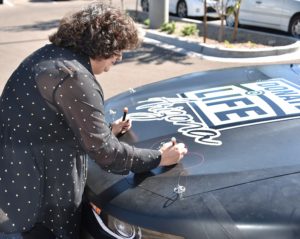
Stephanie Russell adds a message that reads, “I’m so proud of you! Mickey I will honor you till I die!”
Donation shows us how we can all be heroes. In Mickey’s memory, we celebrate the power we all have to serve and change someone’s life through organ, tissue and cornea donation.
Breast Reconstruction Awareness Day
Tracey Warren-Hein is a wife and a mother. She is also a breast cancer survivor and tissue recipient.
In summer of 2017, Tracey was busy living life with her husband and two boys, 6 and 8. She was having sweats accompanied by tender breasts, but dismissed it as pre-menopause symptoms.
“I have no family history of breast cancer, and frankly had the smallest chest possible,” says Tracey. “I’m talking the biggest padded bras out there. Breast cancer was the furthest thing from my mind.”
Her intuition took her to the OB-GYN, where she was told to get a mammogram to put her mind at ease. Then she had an ultrasound and biopsy. In August 2017, she was diagnosed with breast cancer.
Doctors originally told her that the cancer was curable and she wouldn’t need to undergo radiation and chemotherapy. After a double mastectomy, the cancer was found to have spread to multiple lymph nodes. During her mastectomy reconstruction, she received tissue from two tissue donors. It wasn’t until after her procedure that she realized donated tissue was helping her heal.
“I was completely shocked, the entire discovery to surgery process had been a whirlwind,” says Tracey. “Honestly, I had never thought of skin tissue as something that is donated.”
The Role of Tissue Donation
Donor Network of Arizona (DNA) celebrated Breast Reconstruction Awareness (BRA) Day Oct. 17 to emphasize the importance of tissue donation in the reconstruction process and honor those who have battled breast cancer. There were crafts, treats and a photo booth for DNA staff to enjoy.
The objective of BRA Day is to educate women and others about the options for reconstruction following mastectomy. Only 23 percent of women know the wide range of breast reconstruction options available to them, whether they want reconstruction or not. Breast reconstruction is not just about appearance, but also helps some women feel whole again after mastectomy. The goal is to give women hope in some of the hardest times of their lives.
Recovering in body and spirit
Since September 2017, Tracey has undergone chemotherapy and radiation. The support of her family and friends put her mind at ease and helped her through treatment. In June 2018, Tracey had reconstructive surgery.
Although Tracey was initially unaware of the gift of tissue donation, she is grateful for the donors who helped to heal her.
“I have always been an organ donor, but I never imagined I’d be the recipient of such a precious gift. Organ donors are making recipients stronger in body and spirit,” Tracey says.
Build a Better Future for Pediatric Donation
It is because of a compassionate decision and a series of miracles that Zamya Noriega is alive today. The 16-year-old shared the incredible story of her liver transplant to a room full of pediatric donation partners at the Pediatric Symposium on Aug. 24, 2018. Her story is one of many, and with the cooperation of pediatric specialists, there will continue to be stories of faith, hope and healing.
“Build a Better Future for Pediatric Donation” was the theme surrounding this year’s pediatric symposium. Lego blocks and colorful décor welcomed nurses, social workers, child life specialists and more individuals who play a part in saving lives.
Hope Through Tragedy
The day began with the story of a mother who experienced the sudden, tragic loss of her 4-year-old daughter, Addie. Addie was a seemingly healthy little girl, but undiagnosed diabetes caused her brain to swell and hemorrhage, leading to brain death. Micki Parker and her husband Darrell were asked if they would like their daughter to be an organ donor. At the time, Micki worked in health care, so she knew the importance of donation and didn’t think twice. She and her husband “absolutely” agreed for Addie to be a donor. She has written several letters to the recipients that Addie helped, and hopes that they are living full, happy lives. Through the gift of life, Micki has also been able to experience the joy of young Grant, the boy who received Addie’s liver.
“The love I have for Grant, I can’t put into words,” Micki said. “Grant gives me hope that Addie lives on and her life mattered.”
Micki shared her story to emphasize the importance of pediatric organ donation. She also encourages nurses and pediatric partners to do their part to ensure the gift of donation in viable patients.
Building a Strong Foundation
The day was broken up by individual sessions that focused on the building blocks in pediatric donation. Nationally-recognized speaker Dr. Thomas Nakagawa gave a noteworthy presentation on the brain death declaration process for pediatric donors. A panel of experts explored the donation options available in cases that involve medical examiner offices. Renowned doctors Imad Haddad, Mudit Mathur and Daniel Velez also provided insights to improve the world of pediatric donation.
Throughout the event, a video walked the audience through the entire donation process, from a tragic car accident to DNA’s family support after donation. The moving video educated pediatric donation partners and showed the important roles that they play in the donation process. DNA department staff also hosted learning tables for attendees to learn more about transplantation options in pediatric patients and what donation means for donor families.
In closing, Zamya thanked health care professionals and the role they played, and continue to play, in her second chance at life.
“Someone exactly like you saved my life,” Zamya said. “I hope you’ll keep in mind and share my story with your friends and family to honor the little boy who saved my life — and to inspire yourself and your colleagues to keep doing the work you do. It makes a huge difference.”
Transplant Games of America
The bright blue sky makes it hard to distinguish the path of a small, white golf ball, but liver recipient Steve Whitehead watches attentively until he sees the ball bounce onto the green in the distance. Steve and his teammate, Jim Manning, hop into their golf cart and speed off to complete the hole.
Jim and Steve have something more in common than a love for golf. They are both liver recipients, and are competing in Transplant Games of America with every swing. After 18 holes, Transplant Team Arizona competitors pull up at the clubhouse and await the results of their game. The process of displaying points is traditionally done by hand in calligraphy, so the players pass the time by chatting with other teams.
Everyone here has a story and most have a transplant journey to share. Steve and Jim have both attended the games since 2004, though Steve missed the games in 2012 because of his second transplant.
A Growing Community
Every other year, hundreds of transplant recipients and living donors compete in 21 different sports and activities as part of Transplant Games of America. Donor families and supporters of organ, cornea and tissue donation can also attend to cheer on the athletes. The 2018 Transplant Games took place in Salt Lake City, Utah, from August 2-8. This year 40 teams attended, including international teams from Australia, Brazil and India.
Competitors at the games truly represent the entire transplant community. From the youngest at 3 years old, to the oldest at 89, there is a sport for everyone. One of the youngest competitors, 3-year-old Daisy from Transplant Team Arizona, showed off her skills in the Youth Olympiad, cornhole and track and field events. Thanks to her heart transplant, Daisy can run, play and earn medals for her team.
Daisy isn’t the only one who earned medals this year. As the tallying wraps up, it becomes clear that Steve and Jim have placed first in their age group. None of the Transplant Team Arizona competitors would be here today without the generosity of their donors who gave them a second chance at life.
“It’s about honoring your donor, not about the medal count,” Steve says. “It’s about taking time to appreciate the moment and spend time around people who know what you’ve been through.”
Breaking A Record
On the final day of the Transplant Games, competitors gathered to make one more powerful statement in honor of their donors. Recipients stood together and held up signs with the type of transplant they received. They cheered as they broke the previous Guinness World Record for largest gathering of organ transplant recipients. The number to beat is now 540 people.
Transplant Team Arizona made the journey home with 41 medals and, more importantly, a renewed sense of community. To view more photos from the games, click here and here.

